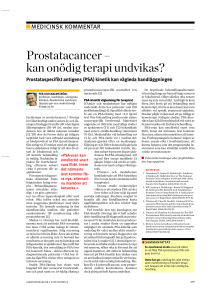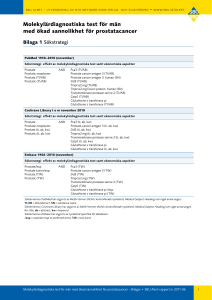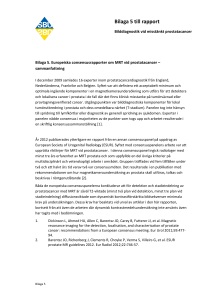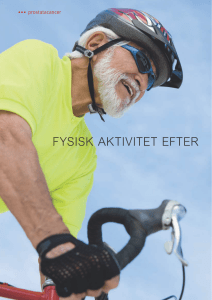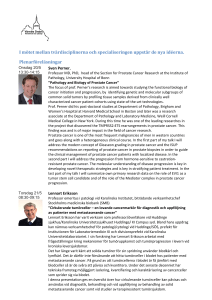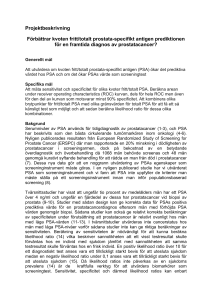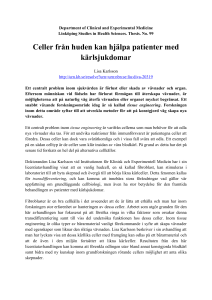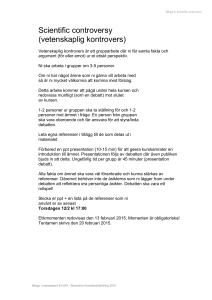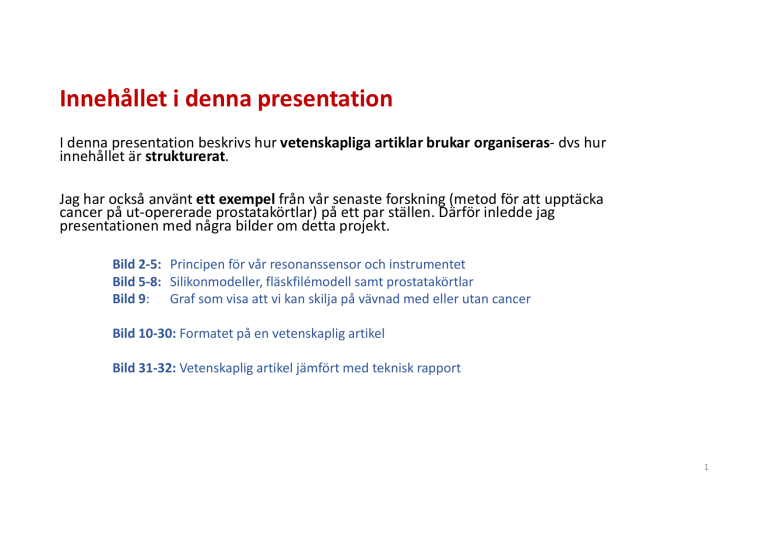
Innehållet i denna presentation
I denna presentation beskrivs hur vetenskapliga artiklar brukar organiseras- dvs hur
innehållet är strukturerat.
Jag har också använt ett exempel från vår senaste forskning (metod för att upptäcka
cancer på ut-opererade prostatakörtlar) på ett par ställen. Därför inledde jag
presentationen med några bilder om detta projekt.
Bild 2-5: Principen för vår resonanssensor och instrumentet
Bild 5-8: Silikonmodeller, fläskfilémodell samt prostatakörtlar
Bild 9: Graf som visa att vi kan skilja på vävnad med eller utan cancer
Bild 10-30: Formatet på en vetenskaplig artikel
Bild 31-32: Vetenskaplig artikel jämfört med teknisk rapport
1
Principen för
resonanssensorn
f
Impedans
fo
fo
V
f
50
150
250
Frekvens (kHz)
Frekvensskift
Df
Vävnad
Impedans
Frekvensspektrats utseende ändras vid
kontakt med ett objekt
Amplitudändring
V
Ändringen beror på ”hårdheten”!
100
Urinblåsa
Prostatakörtel
Tumörer
110
120
Frekvens (kHz)
Prostatacancer: ”Hårdare” områden
på och inuti mjuk vävnad
Urinrör
2
Principen för
hur cancer kan
upptäckas
Steg 1
sensorn
Steg 2
Steg 3
Steg 4
Steg 5
silikon
sensorn
+ silikon
sensorn +
silikon med
hårdare
inneslutet
område
sensorn +
vävnad med
cancer
3
Bild på mätinstrumentet
och en bit fläsk
4
Bild platta silikon- och
fläskmodeller
(Kallas ”modell” om det ska simulera
något- i detta fall prostatavävnad”)
5
Runda (sfäriska) silikon- och
fläskmodeller
Med små kulor av hårdare silikon
– som simulerar områden med
cancer
Silikon
Fläskfilé
6
Prostatakörtel
7
Skivor av
prostatorna för
patologisk cellanalys
Prostata nr 1
Prostata nr 2
8
Resultatet visar att
vi kan skilja på
mätningar som
gjordes där det
fanns cancer mot
där vävnaden var
normal.
Resultat
9
IMRAD - Varför följa den ”mallen”?
Utvecklats historiskt genom:
• Behov av att kommunicera upptäckter och idéer (komma till nytta, föra utvecklingen
framåt, finansiering, inputs)
• Få erkännande till upptäckt
Detta har tvingat fram ett precist och relevant
sätt att informera som kännetecknas av:
•
•
•
•
•
Bara signifikant och korrekt fakta
Objektivitet
Logisk struktur
Entydighet
Specialiserat språk (vokabulär)
Annars risk för att
-
Ignoreras
Får ej publicera
Får ej patent
Får ej pengar
Får ej ”credit”
Gäller alla områden inom
vetenskap och teknik
10
Krav på vetenskaplig text
Fakta: ska vara korrekt, trovärdig och ha en funktion (vara relevant).
Objektivitet: ska inte spela roll ”vem” som gjort studien. Andra ska kunna upprepaIngen plats för tyckande och åsikter!!
Inga värde- eller förstärkningsord! (bra, dåligt, mycket högt värde, fantastiskt resultat)
Logisk struktur: Ska vara lätt att ta del av
Entydighet: Resultatet ska betyda EN sak- det finns EN tolkning.
Ordval och formulering viktig!
Specialiserat språk –(vokabulär) fackspråk: ord, symboler, gemensamma regler –
effektiviserar texten, minskar risk för mångtydighet.
-
Tekniska termer – fotoner, vektor (?), lösning (?), funktion(?)
Vetenskapliga namn: salt- natriumklorid
Förkortningar- bra- förkortar texten, CMOS- Complementary Metal Oxide Semiconductor,
LED, COB - Chip-on-Board (vad behöver definieras?)
11
Typer av vetenskapliga publikationer
Original artikel/forskning - primärkälla
Konferensartikel (ibland peer-review-granskad)
IMRAD
Konferensabstract (ej granskad- annat än formalia)
IMRAD
Full paper (alltid peer-review-granskad)
IMRAD
Översiktsartikel - sekundärkälla
Literature reviews: Sammanställning av litteraturen inom ett område
Qualitative systematic reviews: sammanställning av litteratur inom ett
område med en kritisk granskning. En frågeställning- samla ”data” i
litteraturen, granska studierna/data kritiskt, sammanställ, dra slutsatser.
Quantitative systematic reviews (Meta-analys): Data samlas från många
studier och sammanställs enligt ett systematiskt protokoll. Nya slutsatser
dras ur statistiken
Berättande
IMRAD
IMRAD ?
12
Strukturen på en vetenskaplig artikel
AIMRAD (IMRAD)
Abstract
Introduction
Method
Results
And
Discussion
Naturvetenskap, medicin, teknik
Abstract
-
Abstrakt-sammanfattning
Introduction
-
Inledning (bakgrund + frågeställning +
syfte-mål)
Aim & goal
Method
-
Metod (material och metod)
Results
-
Resultat
Discussion
-
Diskussion
Conclusions
-
Slutsats
-
Referenser
References
13
Abstract
Abstract
Abstract
Introduction
Introduction
Introduction
Aim
Aim
Aim
Results
Method
Method
Discussion
Results
Result 1
Discussion
Result 2
Discussion
Conclusions
Discussion
Result 3
Discussion
Conclusions
Method
General Discussion
Conclusions
14
Vad ska finnas i Inledningen?
Bakgrund:
• Sätta in arbetet i ett större sammanhang, beskrivande bakgrund
• Översikt av närliggande tidigare arbeten (referenser)
- Motivera arbetet
- vad ska göras?
- Göra läsaren intresserad!!
Introduction
Background
Problemställning och problemformulering:
• Logiskt och motiverat leda fram till en problemformulering som
arbetet ska behandla
Problems to be solved
Specificera vad som ska göras:
• Avslutas med en naturlig övergång till Syftet/målet (fråga att
besvara) med arbetet
Aim
15
Introduction
Background
Problems to be solved
Aim
I vissa områden läggs även
detta till på slutet av
inledningen
Syfte
Kort om metod,
resultat och
slutsats
16
Syftet/målet
Här är en fråga som borde besvaras
Det finns ett problem att lösa
Det saknas kunskap för att kunna…
Kort- 1-3 meningar!!
• Syftet med studien var
- att testa hypotesen ….
- att jämföra x med y och målet var att bestämma
vilken som kan bäst uppfylla/användas som …..
Inledning
Frågeställningar:
För att kunna bygga en/skapa ett/konstruera…
För att ta nästa steg i utvecklingen behövs….
Det vore intressant att veta x….
• Målet med detta arbeta var att att utveckla
en modell för att beskriva…../teknik för
att
• I denna studie har vi
utvecklat/undersökt/jämfört….
• I detta arbete har olika tekniker
jämförts/testats…
Således är syftet med detta arbete att ……..
…besvara denna fråga…
….lösa detta problem….
….finna denna kunskap…..
17
Syfte - mål
Goal, Purpose, Aim, Objective,
Syfte - varför man löser problemet, vilken är nyttan?
Mål - vad man vill uppnå med arbetet, mätbart
Ibland diffus skillnad
18
Tempus
Dåtid: allt du gjort- ”målet var att…” Resistansen mättes…Resultatet
analyserades… Värdena beräknades…
Nutid: Det som är allmängiltig fakta, det som anges i publicerade artiklar,
hänvisning till din egen figur.
Passiv eller aktiv form?
Välj passiv! Ibland kan en mening vara aktiv om det förtydligar….
Vi (we) används ibland, men nästan aldrig jag (I)
19
1. Introduction
New reliable and easy to use methods for early detection of prostate cancer (PCa) is very important
and can save lives. PCa is the most common form of cancer among males in the western world. The
predicted number of deaths caused by PCa during 2016 are nearly 76,000 [1]. Only in Sweden, there
were almost 11,000 new cases of PCa diagnosed in 2014 and nearly 2,400 men died due to PCa that
year [2]. The general trend since the late 1980s is an increase in PCa incidence, most likely due to an
increased detection rate of latent disease since the introduction of a blood test for a prostate specific
antigen (PSA) [3]. However, the mortality rates have been showing a decreasing trend in several
countries after 1996, which may be due to the more frequent use of PSA tests [3, 4].
The PSA test and a digital rectal examination (DRE), when the physician palpates the prostate trough
the rectum, are the most common diagnosis methods to indicate PCa. The aim of the palpation is to
detect stiff areas or nodules in the prostate, as it has been shown that tumours are usually stiffer,
compared to healthy tissue [5, 6, 7, 8]. In cases where the result of the DRE indicates presence of PCa,
microscopic evaluation of transrectal ultrasound (TRUS) guided needle-biopsies used as a standard for
final diagnosis [9]. However, these invasive samplings of biopsies still fail to detect 10-30% of PCa.
The results of the DRE are subjective and dependent on the physicians’ experience, therefore an
objective method and quantitative parameter related to the prostate tissue stiffness would be useful
[10].
During minimally invasive surgery (MIS), assisted with robot technology or laparoscopy the surgeon
can only feel the tissue through the instruments, which do not give much feedback regarding tissue
composition [11]. There are recent studies on new techniques in order to improve the tactile feedback
information from such instruments [11, 12]. Tactile resonance sensors connected to the different
surgical instruments might be a useful complement to assess tissue stiffness.
The use of a piezoelectric element as a resonance sensor for detecting tissue stiffness has been
described already in the early 1990s [13]. Tactile resonance sensor systems based on the principle of
an oscillating piezoelectric element which is moved into contact with soft tissue have been used to
measure stiffness variations related to the heterogeneous prostate histology including malignant tissue
[7, 14]. In these earlier studies, measurements were made on slices of a prostate gland [7, 14]. Tactile
resonance sensors have also been used to measure differences in elasticity and stiffness to detect
lesions and oedema [15, 16], to measure the stiffness of the liver which can indicate liver fibrosis [17]
and to detect lymph nodes containing metastases [18].
Bred allmän bakgrund
- Nya metoder för att hitta prostatacancer behövs
- Vanligaste cancerformen
- Många dör
Smalare allmän bakgrund
- Dagens diagnos-metoder
- Palpation
- Brister
Smalare allmän bakgrund- möjligheter
- I robotik behövs ny teknik
Vi har en idé…..
- Ny metod- taktil resonanssensor
- Vi har tidigare utvecklat, visat positiva resultat…
20
A tactile resonance sensor system (TRSS) used for the measurements in this study was presented
earlier [19, 20, 21]. The measured parameters used for detecting differences in stiffness with the TRSS
are the change in resonance frequency of the piezoelectric element, Δf, and the applied force, F, during
the indentation into the measured soft object. A stiffness parameter, F Df [22], could be obtained
from the measured Δf and F as functions of indentation depths, I. Through theoretical models, the
stiffness parameter has been shown to relate to the Young`s modulus, i.e. the elastic modulus of the
measured object [22]. It has earlier been reported on the dependency of the parameters Δf, F and
F Df on the contact angle, α, (i.e deviation from perpendicular contact) indentation velocity, i
-
Mer i detalj om hur metoden fungerar
Tidigare mätningar på platta skivor
and I [19], as well as the depth sensitivity of F Df on flat tissue phantoms [20]. The results from
these studies showed that a contact angle deviating ≤ 10° was acceptable for reliable measurements
and that the detectable depth for the TRSS was 3.5±0.5 mm. However, as a resected prostate gland
has a spherical shape and is enclosed by a membrane, i.e. the capsule, new measurements on spherical
objects are necessary before taking further steps towards a clinical application of the TRSS.
Previous studies have reported statistical evidence that prostate tumours often occur in the peripheral
zone i.e. in or near the capsule [23, 24]. When performing a radical prostatectomy, the positive
surgical margin (PSM) has to be investigated in cases where there are reasons to suspect that the
tumour has penetrated the capsule and is present in the adjacent tissue. Such cases with calls for
additional surgery needs extra attention in order to avoid nerve bundles to minimize the risk of erectile
problems [25, 26, 27].
The aim of this study was to develop and evaluate a clinical TRSS setup enabling detection of cancer
on or close to the surface of whole human prostate. Measurement considerations and comparison with
tissue phantoms as well as with golden standard histopathology were performed.
Ut-opererad prostata är rund
Cancer ofta när ytan
Syftet
Utveckla och utvärdera en metod för att upptäcka
cancer på och nära ytan av hela utopererade
prostatakörtlar. Jämförande studier ….patologiska
studier och mätningar på modeller av vävnad.
21
Metod
Metod
Metod och material
Experiment
Mätningar
För en systematisk review är metoden också viktig:
• Hur/var söktes källorna?
• Vilka studier togs med? Vilka uteslöts? – Varför?- vilka
kriterier (källor, årtal, sökord, områden, annat)?
• Hur/vilka data/fakta valdes ut?
• Vilken kvalitet har materialet? Fanns felkällor, kritisk
analys I källorna, vilken typ av källa- och hur det påverkar
kvalitén
• Hur har data analyserats? (statistiskt?)
Kan innefatta:
• Eventuellt en detaljerad presentation av problemet teori
• Presentation av beräkningar, förenklingar, antaganden
• Motivering av antaganden
• Redovisning av arbetsmetoder och experimentella
metoder
• Beskrivning av instrument och mätutrustning
• Beskrivning av material
22
Resultat
Viktigt avsnitt- här presenteras det som är nytt, det
som åstadkommits enligt syftet.
Men håll det kort- presentera bara resultaten!
(kommentarer, analyser etc kommer i diskussionen)
Gärna grafer och tabeller.
Inga onödiga/överflödiga resultat eller data.
23
Diskussion
• Diskutera resultaten och konsekvenserna av dina
förenklingar och antaganden
• Peka ut avvikelser, oväntade resultat
• Analysera varför ser resultaten ut som de gör?
• Jämför resultaten med andra arbeten
• Föreslå förändringar
• Ge förslag till fortsatt arbete
Systematic review-artikel:
• Hur pålitliga är resultaten? (hur
påverkade urvalet av källor? Kvalitén på
källorna, begränsningar i ämnesvalet?)
• Styrkorna och svagheterna med
studien (t ex val av källor, antal källor,
val av sökord, val av årtal)
24
Slutsatser
• Med utgångspunkt från resultaten och diskussionen presenteras dina slutsatser.
• Återknyt till syftet – har syftet uppfyllts? Om inte – varför?
• Slutsatserna ska placera resultaten i ett större sammanhang!- vad kan dessa
resultat betyda för framtida utveckling/teknik?
• Rekommendationer, vad borde göras i nästa steg?
25
Referenser
Harvard:
The tactile resonance sensor system used in this study was presented
earlier. (Åstrand et al, 2013)
I referenslistan står sedan:
Referenserna i bokstavsordning
Oxford:
The tactile resonance sensor system used in this study was presented
earlier [19].
I referenslistan står sedan:
[19] Åstrand AP, Jalkanen V, Andersson BM, Lindahl OA 2013 Contact angle
and indentation velocity dependency for a resonance sensor – evaluation on
soft tissue silicone models J Med Eng Technol 37(3) 185-196
26
Titel
Locka läsare, innehålla information om huvudsyftet med studien,
nyckelord- (kolla på syftet)
Författare: ska ha bidragit substantiellt, Huvudförfattare först, sedan
ev bokstavsordning, Gruppledaren sist,
27
Abstract
Abstract
Prostate cancer (PCa) is the most common form of cancer among males in Europe and the USA. A
prostatectomy i.e. the removal of the prostate is the most common form of curative treatment. After a
prostatectomy the entire prostate is histopathologically analysed. One area of interest is the superficial
part of the prostate gland as tumour growth on the surface suggests that the cancer has spread to other
parts of the body.
Bakgrund allmänt:
Prostatacancer+ utopererad
körtel
Tactile resonance sensors can be used to detect areas of different stiffness in soft tissue through a
stiffness parameter. It is suggested that tactile resonance sensors can be used to detect prostate cancer
since tumours in the human prostate usually is stiffer compared to surrounding healthy glandular
tissue.
Bakgrund specifikt: taktila
resonanssensorer, tidigare studier
The aim of the study was to detect tumours on, and beneath the surface, of whole human prostate
glands ex vivo using a tactile resonance sensor. Model studies on spherical shaped tissue phantoms
made of silicone and porcine tissue were performed to evaluate the ability of the TRSS to detect stiffer
volumes at a distance beneath the surface. Finally, two resected human prostate glands ex vivo from
patients undergoing surgery for prostate cancer were studied.
Syfte- frågeformulering: vad exakt
gjordes i denna studie + lite metod
From the results it was concluded that the clamping force from the rotatable sample holder did not
affect the magnitude of the stiffness parameter for the silicone samples. For the porcine muscle
samples, the stiffness parameter showed to be affected by clamping forces larger than 800 mN. The
embedded stiff silicone inclusions placed about 4 mm under the surface could be detected in both the
silicone and biological tissue models with a sensor indentation distance of 0.6 mm.
The measurements on resected whole human prostates showed that areas with elevated stiffness
parameter values correlated (p < 0.05) with areas where cancer tumours were detected using
histolopathological evaluation of the prostate. The tumours were significantly stiffer than the healthy
tissue in the dorsal region.
In conclusion, we have shown that a tactile resonance sensor can detect cancerous areas close to the
surface of a whole prostate gland and the results of this study is promising for the development of a
clinically useful instrument to detect superficial prostate cancer.
Resultat: det viktigaste resultaten +
ev kommentarer (diskussion)
Slutsats: De viktigaste slutsatserna+
framtidsvision?
28
Abstract
Prostate cancer (PCa) is the most common form of cancer among males in Europe and the USA. A
prostatectomy i.e. the removal of the prostate is the most common form of curative treatment. After a
prostatectomy the entire prostate is histopathologically analysed. One area of interest is the superficial
part of the prostate gland as tumour growth on the surface suggests that the cancer has spread to
other parts of the body. Tactile resonance sensors can be used to detect areas of different stiffness in
soft tissue through a stiffness parameter. It is suggested that tactile resonance sensors can be used to
detect prostate cancer since tumours in the human prostate usually is stiffer compared to surrounding
healthy glandular tissue. The aim of the study was to detect tumours on, and beneath the surface, of
whole human prostate glands ex vivo using a tactile resonance sensor. Model studies on spherical
shaped tissue phantoms made of silicone and porcine tissue were performed to evaluate the ability of
the TRSS to detect stiffer volumes at a distance beneath the surface. Finally, two resected human
prostate glands ex vivo from patients undergoing surgery for prostate cancer were studied.
From the results it was concluded that the clamping force from the rotatable sample holder did not
affect the magnitude of the stiffness parameter for the silicone samples. For the porcine muscle
samples, the stiffness parameter showed to be affected by clamping forces larger than 800 mN. The
embedded stiff silicone inclusions placed about 4 mm under the surface could be detected in both the
silicone and biological tissue models with a sensor indentation distance of 0.6 mm. The measurements
on resected whole human prostates showed that areas with elevated stiffness parameter values
correlated (p < 0.05) with areas where cancer tumours were detected using histopathological
evaluation of the prostate. The tumours were significantly stiffer than the healthy tissue in the dorsal
region. In conclusion, we have shown that a tactile resonance sensor can detect cancerous areas close
to the surface of a whole prostate gland and the results of this study is promising for the development
of a clinically useful instrument to detect superficial prostate cancer.
Mycket text:
En del läser bara abstrakt
Bara abstrakt är gratis
Sökmotorer söker i abstrakt
Lite text:
Fånga de som har bråttom
Viktigaste info drunknar
Restriktioner från utgivaren
29
A systematic review of image segmentation methodology, used in the additive
manufacture of patient-specific 3D printed models of the cardiovascular system
N Byrne1,2,3, M Velasco Forte2,3, ATandon4, I Valverde2,3,5,6 and
T Hussain3,4
Abstract
Background: Shortcomings in existing methods of image segmentation preclude the widespread adoption of patientspecific
3D printing as a routine decision-making tool in the care of those with congenital heart disease. We sought to
determine the range of cardiovascular segmentation methods and how long each of these methods takes.
Methods: A systematic review of literature was undertaken. Medical imaging modality, segmentation methods, segmentation
time, segmentation descriptive quality (SDQ) and segmentation software were recorded.
Results: Totally 136 studies met the inclusion criteria (1 clinical trial; 80 journal articles; 55 conference, technical and
case reports). The most frequently used image segmentation methods were brightness thresholding, region growing and
manual editing, as supported by the most popular piece of proprietary software: Mimics (Materialise NV, Leuven,
Belgium, 1992–2015). The use of bespoke software developed by individual authors was not uncommon. SDQ indicated
that reporting of image segmentation methods was generally poor with only one in three accounts providing sufficient
detail for their procedure to be reproduced.
Conclusions and implication of key findings: Predominantly anecdotal and case reporting precluded rigorous
assessment of risk of bias and strength of evidence. This review finds a reliance on manual and semi-automated
segmentation methods which demand a high level of expertise and a significant time commitment on the part of the
operator. In light of the findings, we have made recommendations regarding reporting of 3D printing studies. We
anticipate that these findings will encourage the development of advanced image segmentation methods.
30
Vetenskaplig artikel
Teknisk rapport
Kommunicerar ny forskning, ny
kunskap
Många olika syften:
Granskas av andra forskare: Är det ny
kunskap? korrekt genomfört (metod)?
korrekt och tydligt beskrivet? Godkänns
språk, struktur, figurer…? Är slutsatserna
rimliga?
- sammanställning av fakta
- resultatet av en undersökning,
- läget i en teknikutvecklingsprocess,
- resultatet av ett arbete för att lösa ett
problem eller behov.
Läsare: Andra forskare med liknande
Läsare: Chefen, organisationsledning,
Dvs uppnår ett ”djup” (forsknings/kunskapsfronten)
Dvs ofta svagare specialistkompetens hos
läsarna
Kräver precision i språk och upplägg:
• Ska kunna upprepas
• Ligga till grund för fortsatt forskning
Kräver viss förklarande text:
• Fakta och idéer som använts för att lösa
problemet
• Ger rekommendationer för hur problemet
ska lösas
bakgrund
Minimera omfattningen!
företagsledningen.
”Inga” gränser för omfattningen
31
Disposition
av teknisk
rapport
Inledande del
Titelsida
Sammanfattning
Förord
(ev)
Innehållsförteckning
Huvuddel
Inledning
Syfte
Metod
Resultat
Diskussion
Slutsatser
Referensdel
Referenser
Bilagor
32


